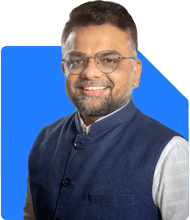Ramalingam Kalirajan |9743 Answers |Ask -Follow
Mutual Funds, Financial Planning Expert - Answered on Jun 21, 2024
He has an MBA in finance from the University of Madras and is a certified financial planner.
He is the director and chief financial planner at Holistic Investment, a Chennai-based firm that offers financial planning and wealth management advice.... more

Namaste Sir I'm having 10lacs in hand where to invest with a safe returns
Understanding Safe Investments
Safety and Returns
Safety in investments means minimizing risks. The returns might not be sky-high, but they will be steady. We will look at options that protect your principal amount.
Emergency Fund
1. Importance of Emergency Fund
Before investing, ensure you have an emergency fund. This should cover 6-12 months of your expenses. It's crucial for financial security.
2. Liquidity
Keep the emergency fund in a liquid asset like a savings account or a short-term fixed deposit. This ensures quick access in times of need.
Fixed Deposits (FDs)
1. Bank Fixed Deposits
FDs are a popular choice for safe returns. They offer fixed interest rates and protect your principal amount. Different banks offer varied interest rates, so compare before investing.
2. Company Fixed Deposits
Company FDs can offer higher interest rates than bank FDs. However, they come with a slightly higher risk. Choose companies with high credit ratings to minimize risk.
Public Provident Fund (PPF)
1. Long-term Savings
PPF is a government-backed scheme with a 15-year lock-in period. It offers attractive interest rates and tax benefits under Section 80C.
2. Tax-free Returns
The interest earned on PPF is tax-free, making it an excellent long-term investment for safe returns.
National Savings Certificate (NSC)
1. Government-backed Security
NSCs are also a secure investment backed by the Government of India. They have a fixed interest rate and a lock-in period of 5 years.
2. Tax Benefits
Investments in NSC qualify for tax deduction under Section 80C. The interest earned is also compounded annually.
Debt Mutual Funds
1. Low Risk
Debt mutual funds invest in fixed-income securities like bonds, government securities, and money market instruments. They are less volatile than equity funds.
2. Types of Debt Funds
Consider liquid funds, short-term funds, or gilt funds for safe returns. These funds offer better returns than savings accounts and FDs with moderate risk.
Systematic Investment Plan (SIP)
1. Consistent Investments
SIP in debt mutual funds ensures consistent investment and risk management. It allows you to invest a fixed amount regularly, spreading the investment over time.
2. Rupee Cost Averaging
SIP benefits from rupee cost averaging, where you buy more units when prices are low and fewer units when prices are high. This reduces the overall cost of investment.
Post Office Monthly Income Scheme (POMIS)
1. Regular Income
POMIS is a reliable investment for regular monthly income. It offers a fixed interest rate and is backed by the government.
2. Safety
Your principal amount is secure, and the scheme offers assured returns. It’s a good option for risk-averse investors.
Senior Citizens Savings Scheme (SCSS)
1. For Senior Citizens
If you are a senior citizen or investing for one, SCSS is an excellent option. It offers higher interest rates and is backed by the government.
2. Regular Interest Payments
SCSS provides quarterly interest payments, ensuring a regular income stream. It also offers tax benefits under Section 80C.
Sukanya Samriddhi Yojana (SSY)
1. For Girl Child
If you have a daughter, consider investing in SSY. It’s a government-backed scheme aimed at securing the future of the girl child.
2. Attractive Interest Rates
SSY offers one of the highest interest rates among small savings schemes. The interest earned is tax-free.
Balanced Advantage Funds
1. Hybrid Investment
Balanced advantage funds invest in a mix of equity and debt. They balance the portfolio based on market conditions, aiming for stable returns.
2. Professional Management
These funds are managed by professionals who adjust the asset allocation to minimize risk and maximize returns.
Gold Investments
1. Safe Haven
Gold is considered a safe haven, especially during economic uncertainties. Investing in Sovereign Gold Bonds (SGBs) or Gold ETFs can provide safety and returns.
2. Inflation Hedge
Gold acts as a hedge against inflation. It maintains its value over time and provides a safety net in your investment portfolio.
Diversification Strategy
1. Spreading Risk
Diversify your investments across different asset classes. This reduces the risk and ensures steady returns. Don’t put all your money into one investment.
2. Balanced Portfolio
Create a balanced portfolio with a mix of FDs, PPF, debt funds, and gold. This ensures stability and growth over the long term.
Regular Monitoring and Review
1. Periodic Review
Regularly review your investment portfolio. Ensure it aligns with your financial goals and market conditions.
2. Rebalancing
Rebalance your portfolio as needed. If one investment grows significantly, consider reallocating funds to maintain balance and reduce risk.
Consulting a Certified Financial Planner (CFP)
1. Professional Guidance
A CFP can provide personalized advice based on your financial goals and risk tolerance. They can help you choose the right investment mix.
2. Ongoing Support
A CFP will offer ongoing support and portfolio management, ensuring your investments stay on track.
Disadvantages of Direct Funds
1. Lack of Guidance
Direct funds don't offer professional guidance. You might miss out on expert advice and risk management.
2. Time-consuming
Managing direct funds requires time and knowledge. Regular funds through an MFD with CFP credential provide convenience and expertise.
Benefits of Regular Funds
1. Expert Management
Regular funds offer professional management. Your investments are handled by experts who monitor and adjust the portfolio based on market conditions.
2. Convenience
With regular funds, you get personalized advice and regular portfolio reviews. This ensures your investments align with your financial goals.
Tax Planning
1. Tax-efficient Investments
Choose tax-efficient investments like PPF, NSC, and debt funds. This will reduce your tax liability and maximize returns.
2. Section 80C Deductions
Maximize your Section 80C deductions. Invest in instruments like PPF, NSC, and SCSS to reduce your taxable income.
Final Insights
Investing Rs 10 lakhs for safe returns requires a balanced approach. Diversify your investments across FDs, PPF, debt funds, and gold. Regularly review and adjust your portfolio. Consulting a Certified Financial Planner can provide valuable guidance and help you achieve your financial goals.
Best Regards,
K. Ramalingam, MBA, CFP,
Chief Financial Planner,
www.holisticinvestment.in
You may like to see similar questions and answers below
Vivek Shah | Answer |Ask -Follow
Financial Planner - Answered on Jun 19, 2023
Advait Arora | Answer |Ask -Follow
Financial Planner - Answered on Nov 22, 2023
Ramalingam Kalirajan |9743 Answers |Ask -Follow
Mutual Funds, Financial Planning Expert - Answered on May 20, 2024
Ramalingam Kalirajan |9743 Answers |Ask -Follow
Mutual Funds, Financial Planning Expert - Answered on Jul 08, 2024
Ramalingam Kalirajan |9743 Answers |Ask -Follow
Mutual Funds, Financial Planning Expert - Answered on Apr 16, 2025
Ramalingam Kalirajan |9743 Answers |Ask -Follow
Mutual Funds, Financial Planning Expert - Answered on Jul 15, 2025
Ramalingam Kalirajan |9743 Answers |Ask -Follow
Mutual Funds, Financial Planning Expert - Answered on Jul 15, 2025
Nayagam P P |8843 Answers |Ask -Follow
Career Counsellor - Answered on Jul 15, 2025
Ramalingam Kalirajan |9743 Answers |Ask -Follow
Mutual Funds, Financial Planning Expert - Answered on Jul 15, 2025
Ramalingam Kalirajan |9743 Answers |Ask -Follow
Mutual Funds, Financial Planning Expert - Answered on Jul 15, 2025
Ramalingam Kalirajan |9743 Answers |Ask -Follow
Mutual Funds, Financial Planning Expert - Answered on Jul 15, 2025
Ramalingam Kalirajan |9743 Answers |Ask -Follow
Mutual Funds, Financial Planning Expert - Answered on Jul 15, 2025
Dr Karan Gupta |128 Answers |Ask -Follow
International Education Counsellor - Answered on Jul 15, 2025
Dr Karan Gupta |128 Answers |Ask -Follow
International Education Counsellor - Answered on Jul 15, 2025
Dr Karan Gupta |128 Answers |Ask -Follow
International Education Counsellor - Answered on Jul 15, 2025






















